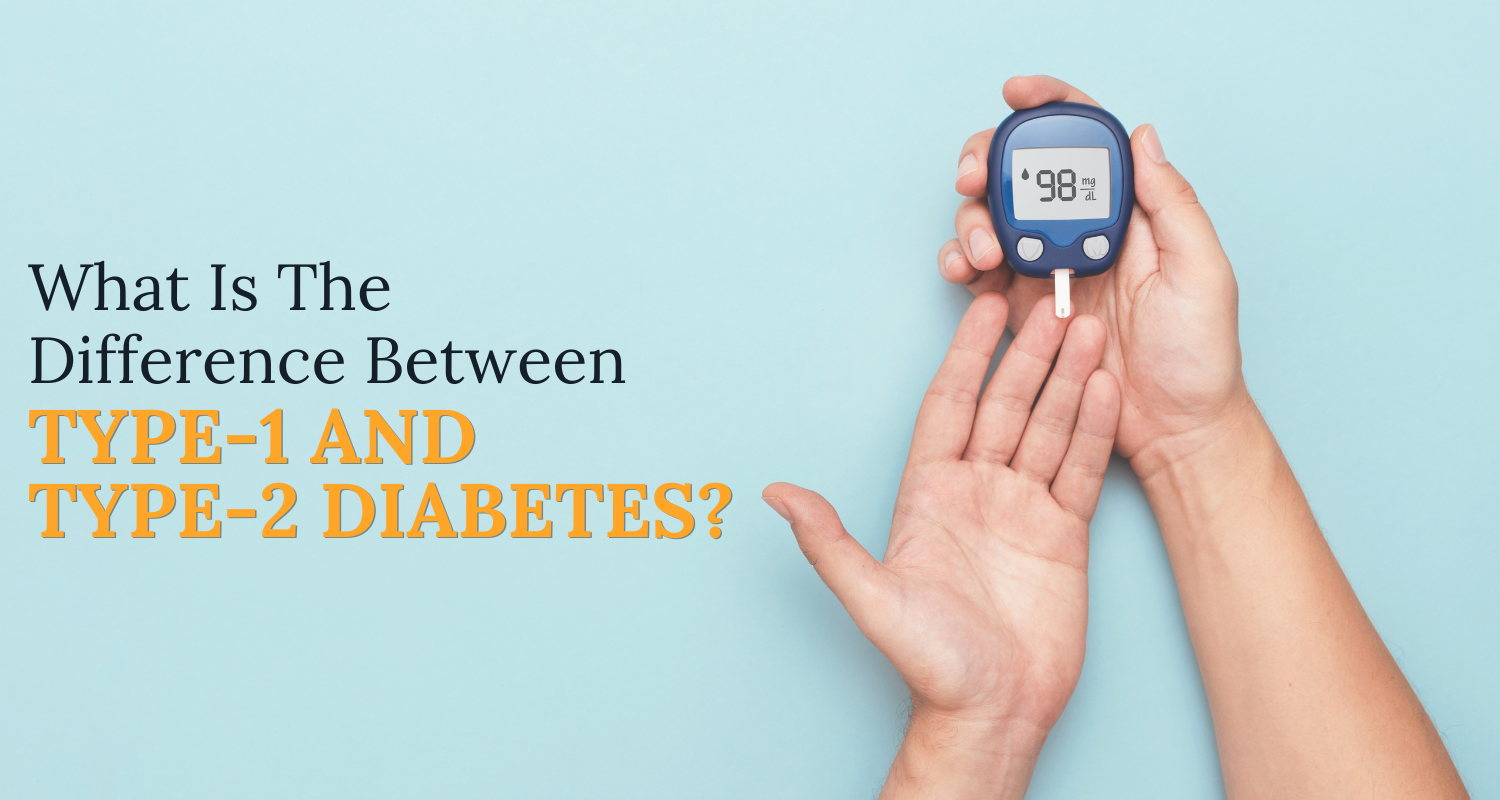What Is The Difference Between Type-1 And Type-2 Diabetes?

Did you know that there are over 34 million people in the United States living with diabetes? Out of these, approximately 5-10% have type-1 diabetes, while the majority, around 90-95%, have type-2 diabetes.
With such a significant number of individuals affected by these conditions, it is crucial to understand what is the difference between type-1 and type-2 diabetes to ensure proper management and care.
In this article, we will explore what is the difference between type-1 and type-2 diabetes, including causes, management, and risk factors – essential knowledge for better health.
Let’s explore what is the difference between type-1 and type-2 diabetes.
Key Takeaways:
Understanding Type-1 Diabetes
In this section, we will focus specifically on type-1 diabetes, also known as diabetes mellitus type 1 or insulin-dependent diabetes mellitus. It is essential to understand the autoimmune nature of type-1 diabetes and the critical role of insulin in managing blood sugar levels.
Type-1 diabetes is characterized by the body’s immune system attacking and destroying the insulin-producing cells in the pancreas. Without sufficient insulin, the body cannot effectively regulate blood sugar levels, leading to potentially dangerous complications.
Prevalence
Type-1 diabetes is less common than type-2 diabetes, accounting for approximately 5-10% of all diagnosed cases of diabetes. It typically develops during childhood or adolescence, but it can also occur in adulthood.
Symptoms
Risk Factors
The exact cause of type-1 diabetes is still unknown, but research suggests a combination of genetic and environmental factors contribute to its development. Individuals with a family history of type-1 diabetes have a higher risk of developing the condition. Other potential risk factors include exposure to certain viruses and low vitamin D levels.
It is important to receive an accurate diagnosis and appropriate management plan for type-1 diabetes. Next, we will delve into the details of type-2 diabetes, providing a comprehensive understanding of its characteristics and associated risk factors.
Understanding Type-2 Diabetes
Type-2 diabetes, also known as diabetes mellitus type 2 or non-insulin-dependent diabetes mellitus, is a chronic condition that affects how the body metabolizes glucose (blood sugar).
Unlike type-1 diabetes, which is an autoimmune disease, type-2 diabetes typically develops due to a combination of insulin resistance and lifestyle-related factors.
Insulin resistance occurs when the body’s cells become less responsive to the effects of insulin, a hormone that helps regulate blood sugar levels. As a result, glucose builds up in the bloodstream, leading to high blood sugar levels. Over time, this can cause various health complications if left uncontrolled.
Symptoms
The symptoms of type-2 diabetes may develop gradually and can include:
Prevalence
Type-2 diabetes is the most common form of diabetes, accounting for approximately 90-95% of all cases. It typically occurs in adults, but it can also affect children and adolescents, especially those who are overweight or obese.
Risk Factors
Several factors can increase the risk of developing type-2 diabetes, including:
While some risk factors, such as genetics, cannot be modified, adopting a healthy lifestyle can significantly reduce the risk of developing type-2 diabetes.
Causes and Risk Factors
Understanding the causes and risk factors that differentiate diabetes type 1 and type 2 is crucial in identifying the factors that contribute to their development. Both types of diabetes have distinct triggers and potential influences, ranging from genetic predisposition to environmental factors and lifestyle choices.
Causes of Type-1 Diabetes
- Genetic predisposition: Certain genes can increase the risk of developing type-1 diabetes.
- Autoimmune response: In type-1 diabetes, the immune system mistakenly attacks and destroys the insulin-producing cells in the pancreas, leading to a lack of insulin production.
- Environmental factors: Viral infections or exposure to certain toxins may trigger the autoimmune response in individuals with a genetic predisposition.
Risk Factors for Type-1 Diabetes
- Family history: Having a close relative with type-1 diabetes increases the risk.
- Age: Type-1 diabetes is commonly diagnosed in childhood and adolescence, although it can appear at any age.
Causes of Type-2 Diabetes
- Insulin resistance: Type-2 diabetes often develops due to the body’s inability to effectively use insulin, leading to elevated blood sugar levels.
- Genetic factors: Certain genes can influence the risk of developing insulin resistance and type-2 diabetes.
- Lifestyle factors: A sedentary lifestyle, poor diet, and obesity can contribute to the development of type-2 diabetes.
Risk Factors for Type-2 Diabetes
- Age and ethnicity: The risk of type-2 diabetes increases with age, and certain ethnic groups, such as African-Americans, Hispanics, and Native Americans, have a higher risk.
- Obesity: Excess body weight, particularly around the abdomen, increases the risk of developing type-2 diabetes.
- Sedentary lifestyle: Lack of physical activity and a sedentary lifestyle contribute to insulin resistance and the development of type-2 diabetes.
By understanding type 1 and type 2 diabetes differences, individuals can take proactive steps to manage their diabetes risk, make necessary lifestyle modifications, and seek appropriate medical care when needed.
Management Approaches
Effective management is crucial for individuals with both type-1 and type-2 diabetes to maintain optimal blood sugar control. The management strategies for type 1 and type 2 diabetes compared, differ due to their unique characteristics and treatment requirements.
Management of Type-1 Diabetes
For individuals with type-1 diabetes, treatment revolves around replacing the insulin that their body cannot produce. This typically involves multiple daily insulin injections or the use of an insulin pump. The goal is to mimic the body’s natural insulin production and keep blood sugar levels within a healthy range.
In addition to insulin therapy, managing type-1 diabetes involves regular blood sugar monitoring, carbohydrate counting, and adjusting insulin doses based on individual needs. Close collaboration with healthcare professionals, such as endocrinologists and diabetes educators, is essential to develop personalized treatment plans.
Management of Type-2 Diabetes
The management of type-2 diabetes focuses on promoting insulin sensitivity and regulating blood sugar levels through lifestyle modifications and medication when necessary. Initial treatment typically includes dietary changes, increased physical activity, and weight loss to improve insulin sensitivity and glucose utilization.
If lifestyle interventions are insufficient, oral medications may be prescribed to enhance insulin production or decrease insulin resistance. In some cases, individuals with type-2 diabetes may require insulin therapy in conjunction with oral medications.
Treatment for Type-1 Diabetes
Insulin therapy is the primary treatment for type-1 diabetes. Various types of insulin and delivery methods are available, tailored to individual needs.
A rapid-acting insulin is used before meals to address immediate glucose spikes, while long-acting insulin provides a steady basal level of insulin throughout the day. Monitoring blood sugar levels regularly and adjusting insulin dosages accordingly is essential for effective treatment.
Continuous glucose monitoring systems (CGMs) can provide real-time feedback, helping individuals make informed decisions about insulin administration and lifestyle adjustments.
Treatment for Type-2 Diabetes
The treatment options for type-2 diabetes include lifestyle modifications, oral medications, and, in some cases, insulin therapy. Lifestyle changes involve adopting a healthy diet, increasing physical activity, losing weight, and quitting smoking. These interventions help manage blood sugar levels and improve overall health.
If lifestyle modifications are insufficient, oral medications such as metformin, sulfonylureas, or thiazolidinediones may be prescribed. These medications work by various mechanisms to enhance insulin sensitivity, reduce glucose production, or stimulate insulin release from the pancreas.
In advanced stages of type-2 diabetes, when oral medications are not enough, insulin therapy may be required to maintain adequate blood sugar control. Management approaches and treatment options for both type-1 and type-2 diabetes are continually evolving with advancements in technology and medical research.
Individuals with diabetes need to work closely with healthcare professionals to personalize their management plans based on their specific needs and goals.
Complications and Long-term Effects
Living with diabetes, whether it be type-1 or type-2, can lead to various complications and long-term effects that can significantly impact individuals’ health and well-being. It is essential to understand and address these potential risks to ensure optimal management and quality of life.
Complications of Type-1 Diabetes
Individuals with type-1 diabetes are at risk for several complications due to the body’s inability to produce insulin.
Over time, uncontrolled blood sugar levels can lead to:
- Cardiovascular disease: Type-1 diabetes increases the risk of heart attacks, strokes, and other cardiovascular complications.
- Kidney problems: High blood sugar levels can damage the kidneys, leading to kidney disease or even kidney failure.
- Nerve damage: Diabetes can cause neuropathy, leading to tingling, numbness, and pain in the hands and feet.
- Eye complications: Retinopathy is a common complication of type-1 diabetes and can lead to vision problems and even blindness if left untreated.
Complications of Type-2 Diabetes
Type-2 diabetes, often associated with insulin resistance, can also result in various complications if not properly managed.
Some of the common complications include:
- Cardiovascular disease: Type-2 diabetes increases the risk of heart disease, heart attacks, and strokes.
- Kidney problems: High blood sugar levels can damage the kidneys and may eventually lead to kidney disease or failure.
- Nerve damage: Diabetes-related neuropathy can cause pain, numbness, and tingling in the extremities.
- Eye complications: Similar to type-1 diabetes, untreated type-2 diabetes can lead to retinopathy and vision problems.
- Foot problems: Nerve damage and poor circulation can result in foot ulcers, infections, and, in severe cases, amputation.
Long-term Effects of Diabetes
Both type-1 and type-2 diabetes can have long-term effects on overall health and quality of life.
Some of these effects include:
- Reduced life expectancy: Poorly managed diabetes can lead to various complications that may shorten life expectancy.
- Quality of life impact: Diabetes complications and daily management can significantly impact an individual’s quality of life.
- Mental health concerns: Living with a chronic condition like diabetes can increase the risk of mental health issues such as depression and anxiety.
Individuals with diabetes must work closely with healthcare professionals to prevent or minimize these complications and long-term effects. Regular monitoring, maintaining a healthy lifestyle, taking prescribed medications, and managing blood sugar levels can all contribute to a better overall prognosis and well-being.
Conclusion
In conclusion, understanding what is the difference between type-1 and type-2 diabetes is crucial for effective management and treatment. Type-1 diabetes, also known as insulin-dependent diabetes mellitus, is an autoimmune condition that requires daily insulin injections to regulate blood sugar levels.
On the other hand, type-2 diabetes, or non-insulin-dependent diabetes mellitus, is primarily linked to insulin resistance and can often be managed with oral medications, lifestyle modifications, and regular monitoring.
It is important to note that while both types of diabetes share some similarities, their causes, risk factors, and management approaches differ significantly. Early diagnosis plays a key role in both types of diabetes.
Recognizing the warning signs and seeking medical attention promptly can help individuals receive the necessary treatment and education to manage their condition effectively.
Additionally, maintaining a healthy lifestyle through a balanced diet and regular exercise is vital in controlling blood sugar levels and reducing the risk of complications.
Furthermore, long-term healthcare management is crucial for individuals living with diabetes. Regular check-ups, screenings, and adherence to prescribed medications are essential to prevent or minimize complications such as cardiovascular disease, kidney problems, and nerve damage.
By prioritizing proper diabetes management and understanding what is the difference between type-1 and type-2 diabetes, individuals can lead fulfilling lives while reducing the impact of their condition on overall health and well-being.
What Is the Difference Between Type-1 and Type-2 Diabetes? – Frequently Asked Questions (FAQs)
What is the difference between type-1 and type-2 diabetes?
Type-1 diabetes is an autoimmune disease where the body’s immune system attacks and destroys insulin-producing cells, requiring insulin therapy for management. Type-2 diabetes involves insulin resistance and can often be managed with lifestyle changes, medications, or insulin therapy in some cases.
How do type-1 and type-2 diabetes contrast?
Type-1 diabetes is typically diagnosed in childhood or adolescence, presenting sudden symptoms like excessive thirst and weight loss, while type-2 diabetes is more common in adults, with milder symptoms that progress gradually. Type-1 diabetes is not preventable, but type-2 diabetes can often be prevented or delayed through healthy lifestyle choices.
What are the risk factors for type-1 and type-2 diabetes?
Type-1 diabetes is primarily linked to a family history of the disease, while type-2 diabetes is associated with risk factors like obesity, sedentary lifestyle, poor diet, family history, age (especially over 45 years old), ethnicity, and certain medical conditions like polycystic ovary syndrome (PCOS).
How are type-1 and type-2 diabetes managed?
Type-1 diabetes is managed with insulin therapy through injections or insulin pump use, while type-2 diabetes management includes lifestyle modifications such as healthy eating, exercise, weight management, oral medications, and insulin therapy as needed. Regular blood sugar monitoring and personalized management plans are crucial.
What are the long-term complications of type-1 and type-2 diabetes?
Both type-1 and type-2 diabetes can lead to long-term complications like heart disease, stroke, kidney damage, nerve damage, eye problems, foot problems, and skin conditions if not properly managed. Good blood sugar control, a healthy lifestyle, and regular healthcare check-ups can help reduce the risk of these complications.
Disclaimer: This content, including advice, provides generic information only. It is not a substitute for a qualified medical opinion. Always consult a specialist or your own doctor for more information. Ingredient Fact does not claim responsibility for this information.






